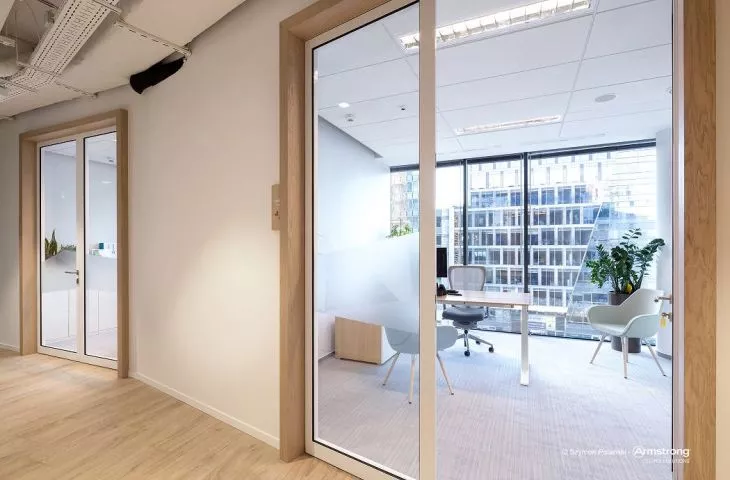70 percent of U.S. respondents want to return to office work - well-prepared workplaces with advantages over home office
What will the return to office work look like? This is one of the most important questions that thousands of professionals and companies have been thinking about for several weeks. But will employees even want to give up their home office to return to an office building workplace? 70% of them say they want to return to the office, according to an analysis the Gensler Research Institute* conducted.
* Gensler Research Institute is an international consulting firm. It employs more than 6,000 professionals around the globe. The 2020 US Work From Home Survey was conducted between April 16 and May 4, 2020 via an online panel on a group of 2,300 full-time US workers employed by companies of 100 or more people.
The proliferating theories about the return to office work in the post-covid era prompted international consulting firm Gensler Research Institute to ask employees directly what they think about working from home and the vision of returning to offices. The sentiment was gauged by interviewing 2,300 employees from 10 different industries. The survey covered a wide variety of age groups - from Generation Z, the Millenial generation and those with little experience, to older workers with age and seniority.
The main finding - as many as 70 percent of respondents want to return to working in an office. Obviously, this model of working behind a desk that worked before the pandemic will be a thing of the past. Both the office buildings themselves and the organization of work will have to change.
We are already slowly seeing these changes. Office owners and tenants are paying attention first and foremost to all hygiene-related solutions. And it's by no means just about disinfecting surfaces. Also the office equipment and furnishings themselves are now expected to meet increased sanitary standards," explains architect Anna Baczkowska, technical advisor at Knauf Armstrong, which specializes in equipping public interiors with acoustic suspended ceilings. The company has just introduced a special solution of the COVID-19 era - hygienic ceilings, but adapted especially to work rooms, as the ceiling tiles have a high noise absorption coefficient (Class A).
Good prospects for office buildings?
Is this positive sentiment a good sign for the office market? Undoubtedly, the working model in offices will change. However, it is hard to imagine a complete lack of return to offices. According to Gensler's analysis, 44 percent of workers can't imagine working from home at all, and 26 percent of respondents assume they could do so 1-2 days a week. Only 12 percent of U.S. workers want to perform business tasks from home on a full-time basis.
The results, published by the Gensler Institute, also confirm new expectations of workers. They want more space, which seems to be a natural consequence of introducing the need for social distance in public spaces and rooms.
The study also shows that both younger and older workers complain about the rotating system at desks that has been fashionable in recent years. They want this to change. Employees care about a workplace permanently assigned to them," notes Anna Baczkowska.
It's also clear from the responses why returning to the office for many people is so important. It's all about longing for interpersonal contact: business meetings (54 percent), socializing (54 percent), meeting with clients (40 percent) and community in general. More than 40 percent of employees also confirm that they want to return to company buildings, as they have good access to technology and the ability to focus on work in the office. As Anna Baczkowska notes, the indication of work comfort is not surprising.
Offices have long focused not only on a comfortable workspace (desk, chair), but also on employee well-being. One of the advantages of good work interiors is friendly acoustics, and this is difficult to find in a home environment, especially in the daily functioning of a family of several people, notes the Knauf Armstrong expert.
Fifty-five percent of respondents also say that remote collaboration is more difficult. And interestingly, it is the youngest employees - seemingly long accustomed to online interaction - who emphasize that the home office makes it difficult for them. It is they, not senior employees, who feel more stressed at the end of the day and lack a sense of a job well done.
This is a natural consequence of the behavior of employees from the Millenials generation, who, as HR and management experts have been pointing out for years, need above all development opportunities, regular and prompt feedback on their work and behavior, and praise. As of 2016, it is not without reason that the younger Millenials are sometimes called the Snowflake Generation. They are extremely affectionate and sensitive.
For them, working in the office community is the realization of not only development, but also just the opportunity to interact quickly with colleagues and bosses. "Snowflakes" won't let office buildings get deserted," concludes Maciej Kiepal, sales manager at Knauf Armstrong.
For more information, visit the company's Armstrong Building Products BV B.V. Sp. z o.o. Oddział w Polsce page on the A&B portal.




















